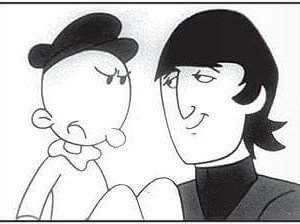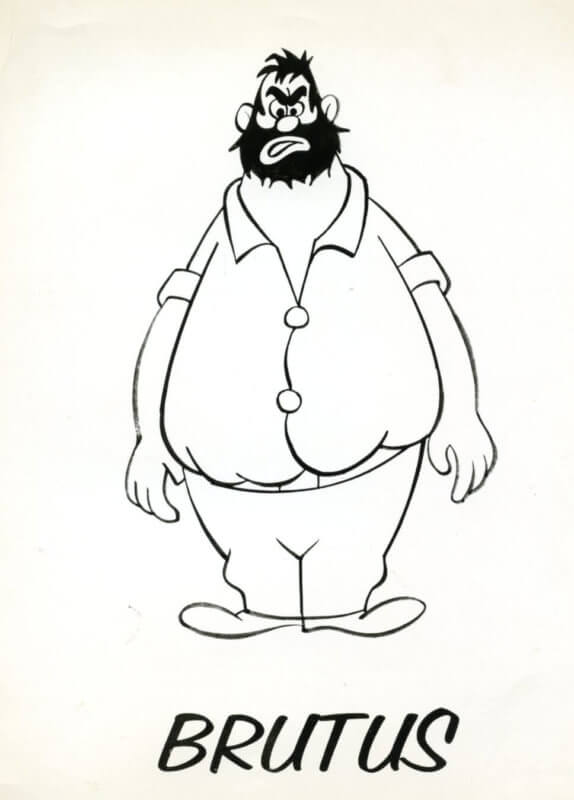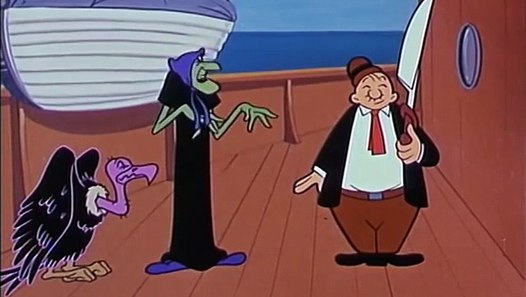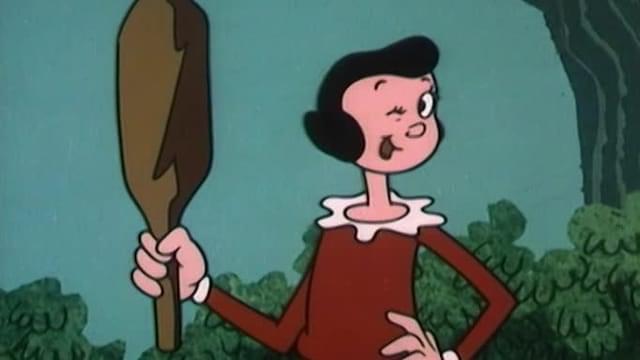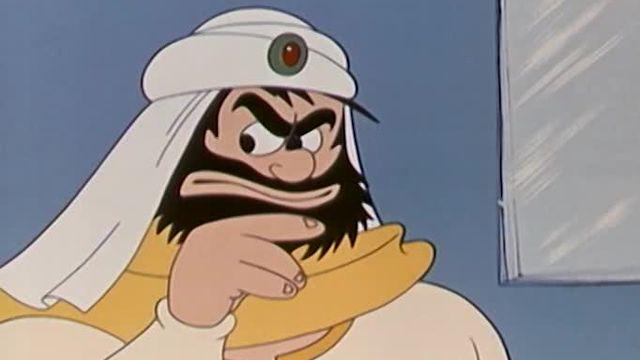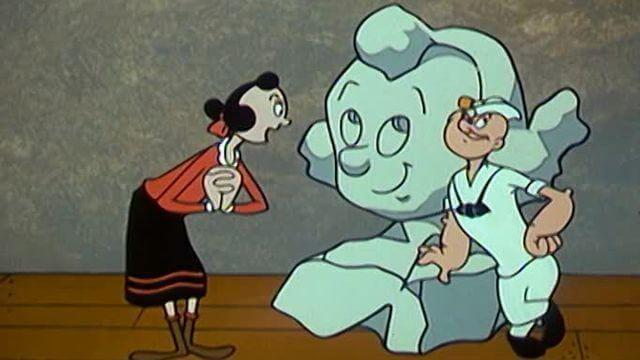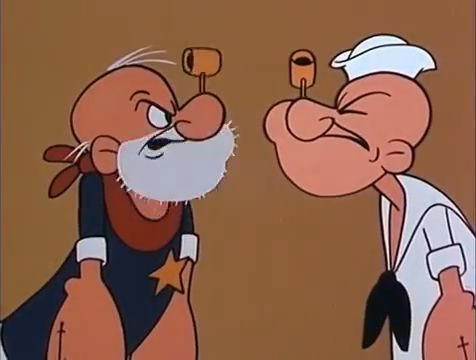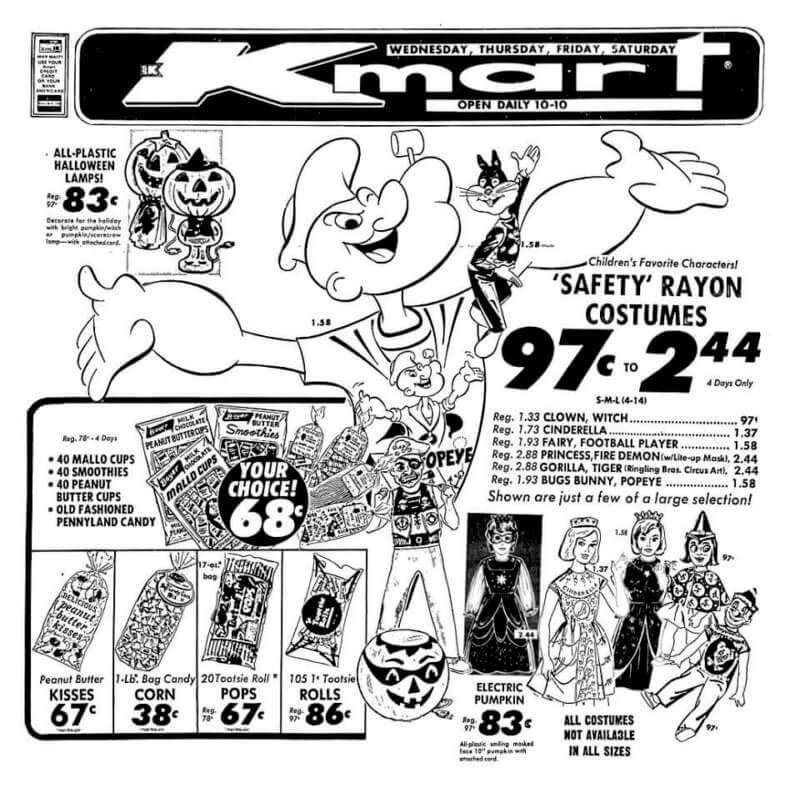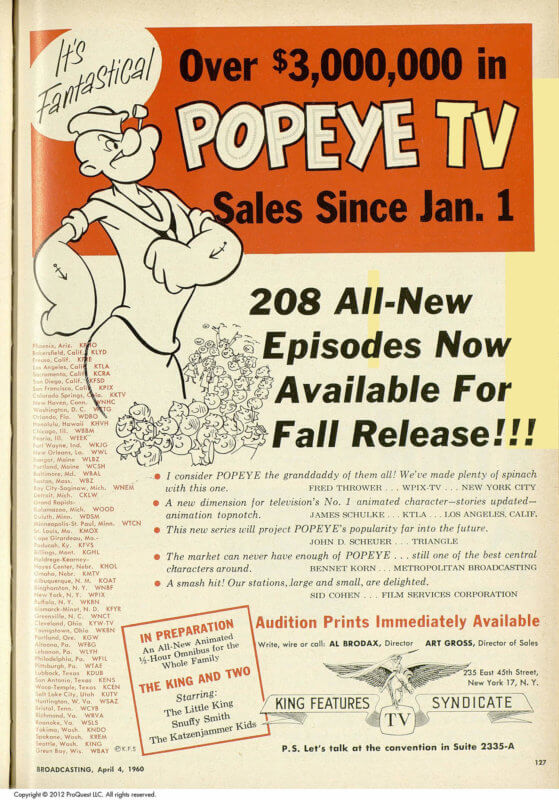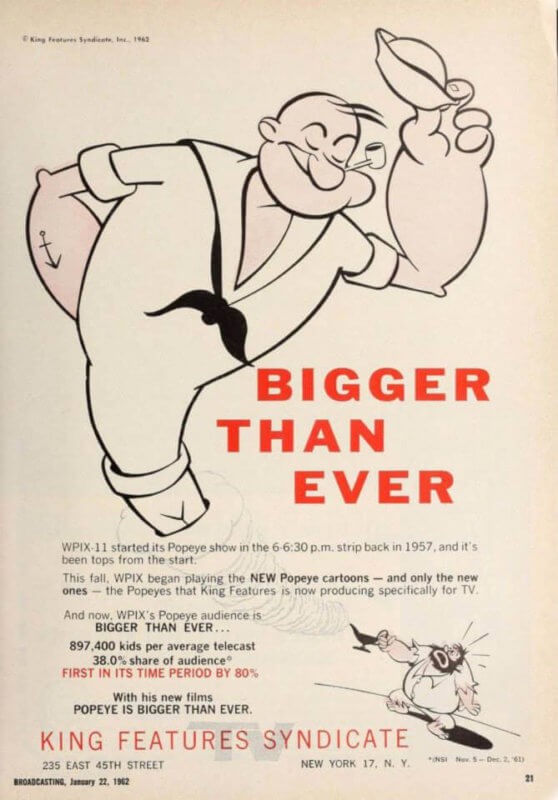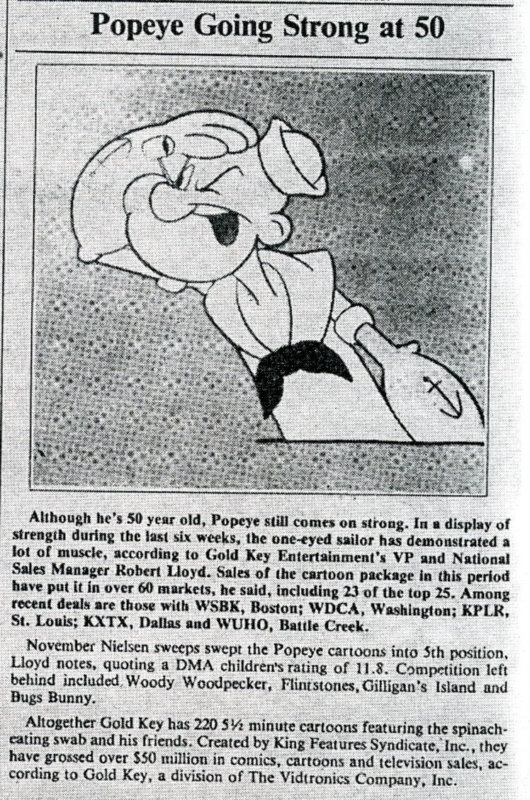When Popeye was the King of Television Cartoons
In 1965 my brother and I turned on a Providence Rhode Island television station before going to school. For thirty minutes we watched The Three Stooges and Popeye. The show aired one Three Stooges short and a Popeye theatrical cartoon. However, much to my brother’s disappointment, The Three Stooges were often dropped and replaced by four Popeye television cartoons. This was my first introduction to the made for television Popeye series. As a little boy I did not notice the animation goofs in the cartoons. I was just thrilled there was so much Popeye to watch. As I grew older, watching these same films, I began noticing the numerous mistakes and wanted to know what happened.
Popeye the Sailor first appeared in the Thimble Theater comic strip created by E.C. Segar on January 17, 1929. Although the strip remained a favorite for several years, the one-eyed sailor is best remembered as an animated cartoon character. Fleischer Studios, who had great success with Betty Boop, adapted Popeye to animation in 1933. Famous Studios assumed production of the series in 1942. Eventually, Popeye and his crew appeared in 234 theatrical cartoons. The series began in black and white but by the end of 1943 switched to color.
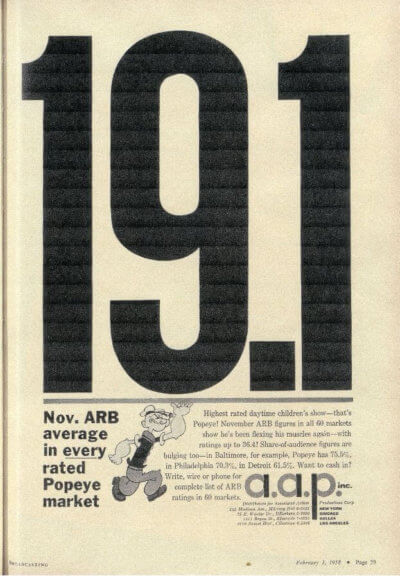
The rating’s success of the theatrical films on television led to the production of the television cartoons
When these same cartoons debuted on television in September of 1956, they were a tremendous hit. Popeye and his cohorts, including Olive Oyl, Bluto, Wimpy and Swee’pea appeared on all types of merchandise. In the December 3, 1958 edition of Variety, Popeye ranked 8th place in the top twenty national syndicated shows. The sailor man ranked higher than Superman and Huckleberry Hound. The November 11, 1957 edition of Broadcasting speculated that Associated Artists Productions, which syndicated the Fleischer/Famous Popeyes, was considering “production of new cartoons featuring the jaunty sailor man.”
This item may have caught the eye of executives at King Features Syndicate prompting action. Although the firm owned the rights to the newspaper strip, they received no income from the distribution of the theatrical films. In was announced in the June 10, 1959 edition of Variety: Push ‘Popeye’ in King Features TV Formed by Hearst. “The Hearst Corporation has formed a new division of King Features Syndicate Special Service which will produce and market filmed television shows based on King Features properties. On the immediate agenda is the production of new ‘Popeye’ animated cartoons.”
Al Brodax resigned his position with the William Morris Agency, to head the newly formed King Features Television Productions. He entered the entertainment industry as a writer for such television series as Celanese Theatre, Pulitzer Prize Playhouse, and Suspense.
Brodax was able to complete production of 220 Popeye segments in 18 months by farming out production to the fastest animators available at the time. He explained the process in Model and Toy Collector’s magazine: “At the time Popeye was running very high in the ratings. These were the old Max Fleischer Popeyes that were distributed by Paramount. I thought it would be a good business move to announce that we’re making 220 new Popeyes in color and that they were up for grabs. The investment was a mere twenty-five thousand dollars for two five and a half minute pieces. The entire series grossed three million dollars in our first year simply by going to the stations who already had big success with the old Popeyes. What I did was I recorded all of the soundtracks in New York to create a uniform sound, and I had a kid waiting downstairs to send the tracks to places like Czechoslovakia, Los Angeles and some went to Australia. But I had six studios going at once to get them all done. Multiple studios were used when you have a limited amount of time on your hands.”
In these new films, Popeye retained his white sailor’s uniform which he wore in the majority of cartoons produced by Famous Studios. The same studio was also responsible for making Olive Oyl’s facial design more attractive. She retained this more appealing look for the television films but wore her attire from the comic strip. The two pilot films for the series are easy to distinguish as the character designs are different in each. Barbecue for Two (Jack Kinney, 1960) featured the principals as they appeared in the comic strip. Popeye wore his black shirt, blue pants, and captain’s hat while Olive Oyl’s homely appearance was pulled straight from the funny papers. While Popeye sported his navy whites in Hits and Missiles (Paramount Cartoon Studios, 1960) Olive wore her short-sleeved shirt and high heels from the Famous Studios films. Another holdover from the Famous Studios theatricals was Popeye sporting two eyes open in the television cartoons.
In Barbecue For Two Popeye’s rival was a hairy brute that the sailor called “Junior.” He would later become known as Brutus. Paramount Pictures claimed they owned the name, “Bluto” although he originated in a 1932 comic strip adventure owned by King Features Syndicate. The Syndicate apparently forgot Bluto’s origin and Brodax renamed him, Brutus.
As King Features Syndicate was at the helm of these new cartoons several characters, who did not appear in the theatrical films, appeared in the television episodes. They included; Rough House who was continually being outwitted by Wimpy the Moocher, bumbling King Blozo, Long-bearded Geezil, hulking Alice the Goon, The Whiffle Hen and Professor O.G. Wotasnozzle (who originated in E.C. Segar’s comic strip, Sappo). Eugene the Jeep, who debuted in the Fleischer films, was afforded more screen time in these new entries. The most notable strip character used in the television episodes was The Sea Hag whom Popeye couldn’t fight due to his strict sailor’s code. Olive usually ate the spinach to take care of the old witch.
As Al Brodax stated, different animation studios were involved in the production of the cartoons. This gave the entire series a schizophrenic look. Producers and directors included Gene Deitch, William L. Snyder, Larry Harmon, Jack Kinney, Gerald Ray and Seymour Kneitel. Most agree the cartoons handled by Seymour Kneitel from Paramount Cartoon Studios are the best in the series. Paramount was behind the theatrical Popeye’s, and many of the same people involved with the earlier films had a hand in these television entries. This is not to say the other studios did not turn out enjoyable cartoons. However many featured animation which was downright sloppy.
Jack Kinney
Cartoons with Hugh Fraser credited as animation director, under Jack Kinney’s unit, are painful to watch. These 1960 entries include Popeye and The Giant (undoubtedly one of the worst animated cartoons in the series), Invisible Popeye, Time Marches Backwards, Camel Aires, Rip Van Popeye, Mississippi Sissy, Popeye the Popular Mechanic, Popeye’s Tea Party, Double Cross Country Feet Race and Old Salt Tale. Mistakes visibility noticeable in Fraser’s directorial efforts include: Popeye’s pipe suddenly disappearing, Olive growing an extra eye under her nose, Brutus in a living room and suddenly (via stock footage) seen laughing at a window, and character’s mouth movements barely matching their dialogue.
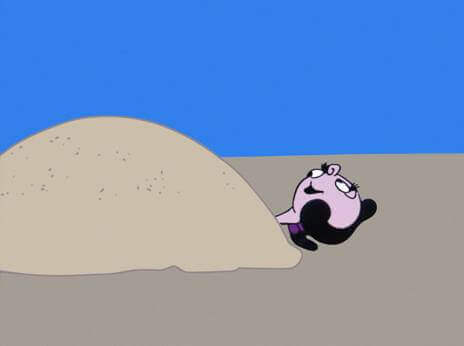
Olive Oyl grows an eye under her nose from Old Salt Tale (Jack Kinney – 1960) a poorly animated cartoon
Osmond Evans was animation director for the stilted Popeye the Fireman (1960). This cartoon features animation which is extremely limited. Equally abysmal is Evan’s Timber Toppers (1960) which features a seemly endless loop of Olive screaming “Help! Help!” Kinney’s cartoons credited to director Eddie Rehberg often have a static feel to the animation. It’s a shame because these episodes are usually hilarious. Forever Ambergris (1960) has Popeye, Wimpy, and Brutus hunting for valuable Ambergris. Frozen Feuds (1960) stars Alice the Goon who is madly in love with Popeye and wants a “moving picture” of him. To satisfy the monster he gives her a television to watch Popeye cartoons! In The Golden Touch (1960) Eugene the Jeep gives King Popeye the ability to turn everything he touches into gold. One of Rehberg’s most memorable is After the Ball Went Over (1960) where Popeye and Brutus compete in a ping pong match. The winner gets a kiss from Olive Oyl. Popeye comments to Olive during the match, “If I gets in trouble I can always uses me spinach gimmick” and “You knows I always wins in these stories.” Totally out of character Popeye cheats injecting Brutus’ ball with explosives. Popeye gets blown up by mistake! Olive asks the injured sailor if there is anything special he’d like. His reply is “Yeah, a new writer to writes me spinach back in the script.”

Jack Kinney’s animation director’s facial designs of Popeye varied (From left to right – Ken Hultgren, Rudy Larriva, Eddie Rehberg and Hugh Fraser)
Other animation directors under Jack Kinney’s supervision produced well-animated cartoons. Harvey Toombs delightful contributions included Popeye the Lifeguard (1960) where the sailor says to Olive, “no more pretty girls for me..only you Olive!” Popeye the Piano Mover (1960), Bell Hop Popeye (1960) and Coffee House (1960). Olive Oyl joins the beatnik crowd in Coffee House, and Popeye eats spinach doused with culture to rescue her from beatnik Brutus. Rudy Larriva’s enjoyable efforts included Popeye and the Polite Dragon (1960), Popeye and Buddy Brutus (1960), and Private Eye Popeye (1960), where Popeye, Olive, and Eugene the Jeep tangle with both The Sea Hag and Brutus. Other cartoons under Larriva’s direction were The Square Egg (1960), Skyscraper Capers (1960), Popeye’s Cool Pool (1960) and Paper Pasting Pandemonium (1960). Brutus’s wallpaper seen in Paper Pasting Pandemonium included Popeye comic strips illustrated by Bela Zaboly. Among Volus Jones’s imaginative output was Sweapea Thru the Looking Glass (1960, where the lad and Eugene the Jeep visit a land similar to the one depicted in Alice in Wonderland), Wimpy’s Lunch Wagon (1960) and Uncivil War (1960). Uncivil War is a humorous episode illustrating the dangers of dangerous driving. Although purely a Jack Kinney effort, when this cartoon was distributed to public school systems as an educational tool, a concluding song replaced Popeye’s original dialogue. A safety song, sung by the sailor, was utilized and animated by Paramount Cartoon Studios. Ed Friedman shared credit with Volus Jones in these well animated and entertaining cartoons; Shoot the Chutes (1960), Popeye’s Service Station (1960), Popeye’s Pep-Up Emporium (1960), Popeye’s Hypnotic Glance (1960) and Popeye the Ugly Ducklin (1960). In Popeye the Ugly Ducklin the sailor tells Swee’pea about his early years as a youth growing up on Goon Island. Spare Dat Tree (1960), Popeye’s Trojan Horse (1960), Popeye and the Spinach Stalk, The Golden Type Fleece (1960), The Green Dancin’ Shoes (1960), Popeye and the Phantom (1960), The Blubbering Whaler (1960), and Ballet de Spinach (1960) were fine efforts credited to Ken Hultgren. Olive sported her comic strip hairstyle in Ballet de Spinach. Brutus, laughing at the window, originated in this episode to be jarringly incorporated in Hugh Fraser’s Popeye and the Giant and Popeye the Popular Mechanic. Aside from their clothes each of Kinney’s animation directors utilized different visual designs for the characters. Jack Kinney’s studio took on the bulk of the series turning out one a week. This grueling schedule no doubt contributed to the unevenness of his studio’s output. The fast production and different crews meant some cartoons would look better than others.
Larry Harmon
Larry Harmon, aside from his contribution to the television version of Popeye, produced several Mr. Magoo and Dick Tracy cartoons from the same period. He is best known for buying the TV rights to Capitol Record’s Bozo the Clown! Harmon’s cartoon and live action versions of Bozo were staples on TV screens for decades. Animation goofs included brief moments where the sailor and Brutus wore short-sleeved shirts only to have them become long sleeved in the next scene. These wardrobe malfunctions are in Dead-Eye Popeye (1960), Ski-Jump Chump (1960) and Foola-Foola Bird (1960). Characters spoke with their mouth’s wide open and heads bobbing back and forth. The plots are fast-paced with a lot of action. Enjoyable entries in this series include Foola-Foola Bird (1960), Childhood Daze (1960), Irate Pirate (1960), Crystal Ball Brawl (1960) Track Meet Cheat (1960) and Caveman Capers (1960). In Caveman Capers Popeye explained his spinach diet started with his great, great ancestor who was a caveman!
Gene Deitch
Supervising director Gene Detich is credited along with producer William L. Snyder. Deitch’s efforts often featured animation so simplified Olive Oyl would be carrying an armless Swee’pea. Despite the simplification, the animation was fluid, and the character’s moved. The better efforts under his direction were Seeing Double (1960), where Popeye battles his robot twin, The Lost City of Bubble-On (1960), and Goon With the Wind (1960). Other good episodes include Insultin’ the Sultan (1960), Spoil Sport (1961), where Popeye’s mode of transportation is a scooter which displeases jet setter Olive Oyl, Disguise the Limit (1961), Canine Caprice (1962), Roger (1962) and There’s No Space Like Home (1960). In There’s No Space Like Home, a historic moment occurred in the midst of a battle! While fighting pint-sized aliens, Brutus feeds Popeye his spinach saying, “This looks like a job for Popeye!” Two uniquely animated cartoons from Deitch were Have Time Will Travel (1961) and Intellectual Interlude (1961). Each had an animation style similar to the theatrical cartoons from UPA best known for Mr. Magoo.
Deitch had this to say about his efforts on the series, “I did a whole slew of ersatz Popeye films directly for King Features Television. I had mixed feelings about it, as Segar’s newspaper strip was always my number one favorite as I grew up in the 1930’s and 40’s. I did insist to Brodax that we at least bring into our serials as many as possible of the great supporting characters of the strip, such as Wimpy, Eugene the Jeep, The Sea Hag, Alice the Goon, etc. We had a chokingly small budget. I desperately needed the work at that time, so I took it on and did my best with the storylines I was given by Brodax to get as close as I could to the Segar feel. It was not easy with the money we had, and the inexperienced international crew (Czechs, Italians, and Croatians). It was fun working with voice actors Jack Mercer (Popeye, Wimpy, and Poopdeck Pappy) and Mae Questel (Olive Oyl, The Sea Hag, and Swee’pea), who recorded their lines half a world away from each other! I certainly don’t regret my work on the Popeye serial.” Jackson Beck joined Mercer and Questel voicing Brutus and Professor Wotasnozzle. This talented trio were the only voice artists for the entire series.
Several of the cartoons featuring Deitch’s name were animated by Halas and Batchelor. In the December 1, 1960 edition of Television Today, an article titled Halas and Batchelor Land Big American Cartoon Order explained: “Successful cartoon-making production company, Halas & Batchelor Films, have landed a contract to produce a new series of Popeye films for America. Popeye will now take adventures into space or traveling of luxury liners.’
The animation in the Halas and Batchelor episodes was excellent. Among the team’s episodes were Potent Lotion (1960), Matinee Idol Popeye (1960), The Billionaire (1961), an amusing take-off on the television series, The Millionaire, Model Muddle (1960), Which is Witch (1961) and Weight For Me (1961). In Weight For Me Olive Oyl eats so much while waiting for sailors, Popeye and Brutus, she grows enormous! Brutus likes her new size, but frantic Popeye tries to reduce her weight.
Gerald Ray
Gerald Ray’s, TV Spots, is best known for animating the adventures of King Leonardo and his true-blue companion Odie, the skunk. The rudimentary animation style to Ray’s Popeyes fit their comic storylines. Jeopardy Sheriff (1960) had Poopdeck Pappy telling tall tales to Swee’pea only to get mixed up with real bank robbers. Pick Pocket Peter hijacks Popeye’s spinach which lands in his father’s mouth! The old sailor beats up the robbers and saves the day. In Take It Easel (1960) Popeye and Brutus compete in a painting contest. The sailor pants a can of spinach to become victorious over his devilish rival. Each of Ray’s cartoons ended with characters singing lyrics to Popeye’s instrumental theme song. In Egypt Us (1960) Popeye and Olive find out what happens when they leave Wimpy to mind the barbecue! An overstuffed Wimpy sings at the film’s conclusion, “It’s bad to be tardy to a hamburger party says Wimpy the Burger Man! Wimpy’s shirt button’s pop off in place of Popeye’s “toot,” “toot” of his pipe.
Paramount Cartoon Studios
As previously noted Paramount Cartoon Studios is regarded as producing several of the series’ best episodes. Although with a lower budget many films look as though they were merely an extension of the later Popeye theatricals. Among the finest are The Spinach Scholar (1960, where Popeye goes back to school to get educated and flunks out of each grade, Rags to Riches to Rags (1960), Mobey Hick (1960) and Hair Cut-Ups (1960 where Popeye takes Swee’pea to get his first haircut). Other great episodes are Voo Doo to You, Too (1960), The Baby Contest (1960), where Swee’pea eats the spinach to save Popeye from Brutus, Scairdy Cat (1961), County Fair (1961), where the audience finally learns there is something special about Popeye’s brand of spinach, Sneaking Peeking (1961), The Medicine Man (1961) and Popeye Thumb (1961). Popeye Thumb retells the famous fable with spinach playing a primary role. Olive Oyl would resort to eating Popeye’s favorite food to save him from The Sea Hag! She grew muscles and bopped the witch in Paramount’s Gem Jam (1960), Hamburgers Aweigh (1961), Popeye’s Double Trouble (1961) and A Poil For Olive Oyl (1961). In Giddy Gold (1961) she ate Popeye’s spinach to punch a siren that was using her harp to put her boyfriend in a trance. The stories used in Poppa Popeye (1960), The Valley of the Goons (1960), It Only Hurts When They Laugh (1960), What’s News (1960), Me Quest for Poopdeck Pappy (1960) and Myskery Melody (1961) all originated from E.C. Segar’s comic strip. Several of the Paramount cartoons ended as they did in the Gerald Ray cartoons. A character would conclude singing a song to the Popeye the Sailor Man theme.
Unfortunately, the poor animation in the Jack Kinney efforts and the overall simplification of the character designs tend to cast a negative tone on the entire series. Critics forget about the many enjoyable moments the cartoons had to offer. These cartoons were a huge financial success for King Features Syndicate. According to an article in the October 25, 1961 edition of Variety: “King Features Syndicate’ sales of the new made-for-TV Popeye cartoons have just passed the $4,500,000 mark. King has so far delivered 150 of the new Popeyes. Production of the remaining 70 is due to be completed early next spring. Animation is being done in both Hollywood and New York.”
The June 10, 1964 edition of Variety carried the headline, “Popeye’s $20,000,000 Gross” which detailed the success both the theatrical and made-for-TV cartoons were having on television. In 1964 190 U.S. stations aired the theatrical films with King’s Popeye sold to about 125 stations. The success of the new Popeye series increased the amount of licensed merchandise. There were so many new products that King Features Syndicate published a Popeye merchandise catalog in 1962.
Ratings remained high for these Popeye cartoons for several years after their televised debut. The June 30, 1975 issue of Broadcasting listed the ten non-network top-rated children’s syndicated programs. Popeye’s made for television cartoons ranked in sixth place. The magazine cited, “In Charleston, S.C. it wipes out the competition at 10 a.m. Sunday with a 13 rating and stripped at 3 p.m. in Dallas, it hits a six rating.”
The series continued to air on U.S. television stations until the mid-1990s when many independent television stations ceased broadcasting non-network syndicated programs for children. Today the cartoons can be viewed on Hearst’s Popeye and Friends official You Tube channel.



